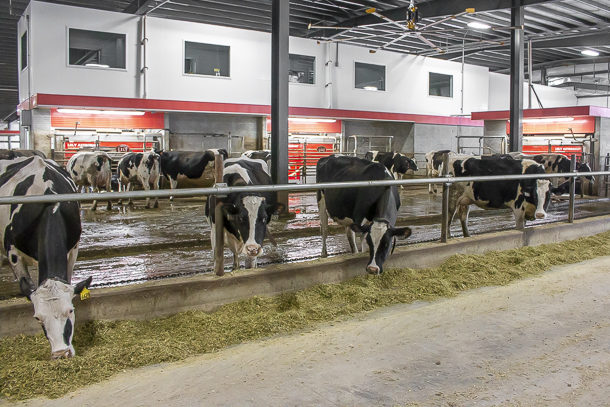Automation in the dairy industry is moving fast, ever-changing and improving every day. The options are abundant for the modern dairy farmer. Yet, mixing cows and machines is always going to be a challenge. Understanding the cows is the first consideration, and the machine, whatever it is, must fit their behavior.
At one end of the scale is the fully robotic dairy, where the cows decide for themselves when to be milked and make their own way to a milking robot. After sanitizing the udder, harvesting the milk, sanitizing the udder again and collecting data, the cow is released to go and feed, rest and make more milk.
To adjust to robotic milking, the cows must learn completely new routines. These changes are best introduced incrementally by first allowing individuals to check out the new machines. Robotic milking machines have a training mode, familiarizing the cows with the process before they even start harvesting milk. Cows are often fed by the robot to encourage them to keep coming back. Milking robots are at the top end of technology in milking automation, but they are not for everyone.
At the other end of the automation scale are things such as barn sweepers, automatic cluster removers, robotic teat sprayers, automated sort gates and even crowd gates with artificial intelligence (AI).
When considering introducing automation into the milking regime, consider how your herd will adjust to it and how to make the transition cow-friendly.
It is true cows are creatures of habit, but they are more than that. They are individuals. Within a herd there will always be dominant cows – the leaders of the pack, the first to be milked, the first to the feedbunk, the alpha cows. Usually the biggest and highest-producing animals, they seem to know their value and use it to their social advantage. They also have an influence on the herd. Habits are not formed overnight, and it may take a while for cows to adjust to the change of automation, but those dominant cows will lead the pack.
Changes to the herd's daily routine need to be done with care and understanding of the cows’ world. Take, for instance, the two following real-life scenarios:
- Farm A: 1,200 cows were milked in the adjacent double-12 herringbone while the 60-stall rotary parlor was being built. The yard work was all done, and the final install details were happening. After milking in the herringbone, the cows had free access to the new yard layout. This was a smart move by a smart farmer who thought about their cows and allowed them to familiarize themselves with what was about to become a part of their new routine. The on-site technicians reported that it was the most trouble-free transition from herringbone to rotary they had ever seen. This family-run farm is now milking around 2,800 cows.
- Farm B: The farm installed a 106-stall rotary for 5,000 cows. About 100 yards away was the aged 50-stall rotary where the cows were used to going. While these cows were used to stepping onto a moving rotary platform, in the new parlor, everything else was unfamiliar. On that first day, they would not even progress down the yard without checking out every post and rail of the yard, the crowd gate or the new concrete. It was a long, slow, noisy, stressful process for the staff and the cows alike. It took several weeks before the cows and people were accustomed to the new routine.
Automation in the parlor does not only apply to new builds. Many automation products can be retrofit into existing operations, such as automated teat sprayers. A prerequisite for automated teat sprayers in rotary parlors is to fit leg spreaders to the surface of the rotary platform to encourage the cows to stand with their hind legs apart. These are separate devices from the actual teat sprayer; nonetheless, they are crucial. It is advised that these be fitted a week or two in advance of commissioning the teat spraying robot to allow the cows to adjust to one change at a time. Once the leg spreaders become normal in the cows’ world, then introduce the teat sprayer. This approach achieves a less disruptive result.
Cows are very attentive to their surroundings. They see new things, hear new noises and smell new smells. Cows will be aware of new people in their routine and will respond to the vibe of the people they interact with. Calm, relaxed and confident people help the cows to feel the same.
Introduce cows to changes progressively, whether it is a robotic teat sprayer, an automated sort gate or even new people. Too many changes all at once are a lot for a cow to process, no matter how many cows are in the herd.
When introducing automation into the dairy, be patient, have a plan, consider the cows and make it easy for them. It will be easier for the team too. It takes time for new to become normal, and little by little, step by step is the best way.






